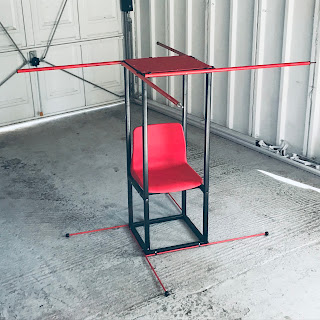It all began with a spare chair knocking around the workshop and as we contemplate a way forward one option with the three-quarter scaler is to build entirely from scrap as we've done to date and to use it solely for a promo pic for the website.
What it principally functions as is a means of figuring out how it all hangs together and whether it looks viable to scale up. Nonetheless we cannot risk trying to fly an overly flexible drone and failing, because that costs money and time and effort.
Better I think to bite the bullet once back from the studio with the current build, and commence a full-scale version with more exotic materials that provide the required rigidity.
If nothing else I'll be left with a very high-tech chair to sit on, and between you and me I think it's the most imaginative part of the whole exercise. I've posted papers to the digital commons and actually the bulk of commercial interest judging from the data is actually in the stand-up version of the suspended space-frame.
Again tho' we shall persevere with seated versions because, to paraphrase JFK I do it not because it is hard, but because it is easy.
Note from the pic that the 15-inch footprint used for the child-sized flyer has only to be enlarged to around 18- or 20-inches in order that I can sit in it myself.
Prior to that decision we shall need to see what size of space-frame I can squeeze into, as we're flying on the edge here. As ever there are precedents... Nigel Mansell's F1 cockpit was so tight a fit that he'd to cut the toes off his footwear in order to race.

















